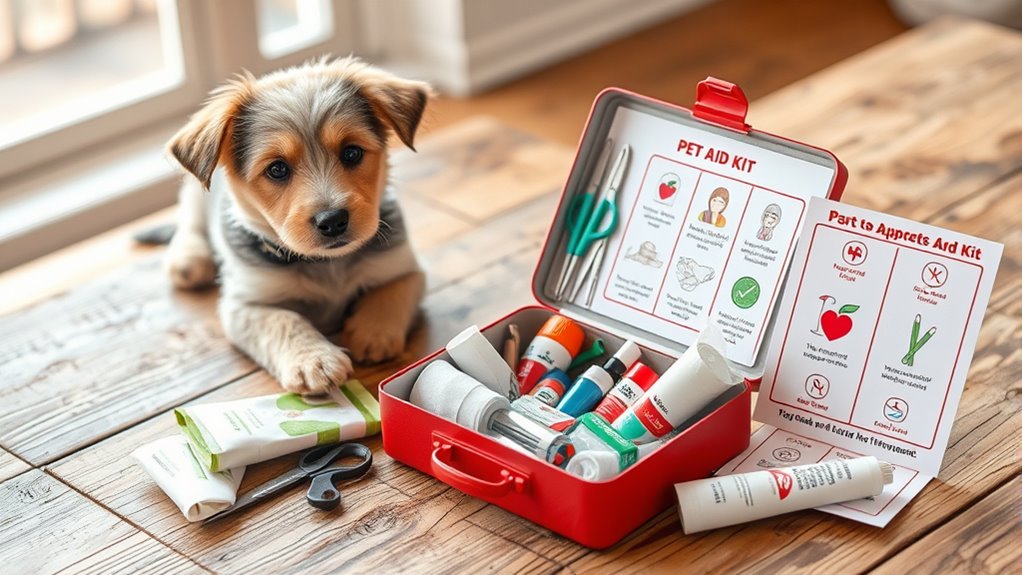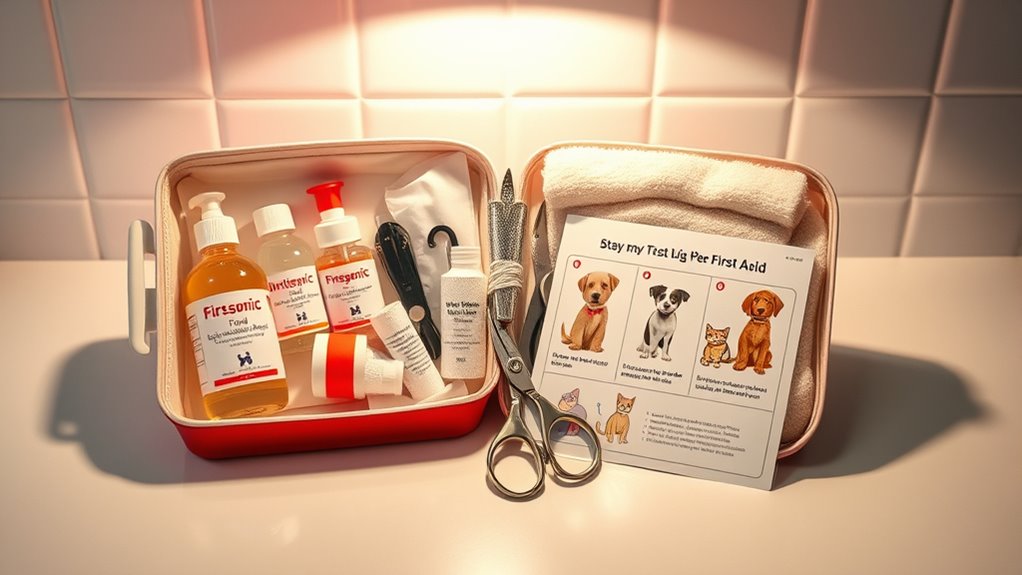To prepare a pet first aid kit, gather essentials like sterile gauze, adhesive bandages, antiseptic wipes, and vet-approved ointments for wound care. Include a thermometer, tweezers, scissors, and items for choking or bleeding emergencies. Store everything in an accessible container and check supplies regularly. Learning how to use these supplies effectively is vital. Keep exploring to discover detailed tutorials and tips to guarantee you’re prepared for any emergency.
Key Takeaways
- Gather essential supplies like sterile gauze, antiseptic wipes, topical ointments, tweezers, and scissors for wound care.
- Include monitoring tools such as a digital or rectal thermometer, gloves, and an emergency blanket for temperature and shock management.
- Stock emergency items like a bulb syringe, pet airway, and bleeding control supplies for choking and airway emergencies.
- Organize your kit in an accessible container, regularly check expiry dates, and store extra supplies for multiple emergencies.
- Learn basic first aid techniques through tutorials and practice handling common pet injuries and emergencies confidently.

Having a well-stocked pet first aid kit is essential for addressing emergencies swiftly and effectively. When it comes to pet safety, being prepared can make all the difference in how quickly you respond to unexpected situations. No matter if you’re at home, on a walk, or traveling, having the right supplies organized and ready ensures you’re equipped to handle minor injuries or urgent health issues. Effective emergency preparedness starts with understanding what to include in your kit and knowing how to use those supplies properly.
A prepared pet first aid kit ensures quick, effective response to emergencies wherever you are.
First, gather basic items like sterile gauze pads, adhesive bandages, and medical tape to control bleeding or cover wounds. It’s also wise to have antiseptic wipes or solutions, such as chlorhexidine, to clean cuts or abrasions. For pain relief, include vet-approved topical creams or ointments, but never give human medications unless directed by a veterinarian. Having a pair of tweezers helps remove splinters or debris from your pet’s skin. Scissors are useful for cutting bandages or clothing if necessary. Additionally, keep a digital thermometer to monitor your pet’s temperature, and note that a rectal thermometer provides the most accurate reading.
Beyond wound care, include supplies for choking or airway emergencies, such as a bulb syringe for clearing nasal passages or a pet-specific oral airway if you’re trained to use one. Also, store a copy of your pet’s medical records, including vaccination history and any ongoing treatments. This info can be crucial for veterinarians in an emergency. Keep extra supplies like gloves to prevent contamination, and consider including a leash or harness to secure your pet during transport. An emergency blanket can help keep your pet warm if they’re in shock or exposed to cold temperatures.
You should also familiarize yourself with basic first aid techniques—like how to stop bleeding, perform CPR, or handle a choking pet. Practice using the supplies so you’re confident in an emergency. Remember, having a well-organized kit isn’t just about collecting supplies; it’s about knowing how to use them effectively for pet safety. Regularly check expiration dates on medications and replace used items. Keep your pet’s first aid kit in an accessible, known location, and ensure all family members or caregivers know where it is and how to use it. Being prepared with a detailed pet first aid kit not only boosts your confidence but markedly enhances your emergency preparedness, ensuring your pet’s safety during unforeseen situations. Additionally, understanding the importance of attention can significantly improve your response times in emergencies, allowing you to act swiftly and accurately.
Frequently Asked Questions
How Often Should I Update My Pet First Aid Kit?
You should update your pet first aid kit at least every six months to guarantee kit maintenance and check expiration dates on medicines and supplies. Regularly review the contents for any damaged or expired items, replacing them promptly. Keep an eye on your pet’s changing needs and add new supplies as necessary. Staying proactive helps you be prepared in emergencies and ensures your kit remains effective when needed most.
Can I Use Human First Aid Supplies on Pets?
Using human first aid supplies on pets is like trying to fit a square peg in a round hole—you might cause more harm than good. Human supplies are often not suitable for pets because they lack pet-specific products designed for their unique needs. Always stick to pet-specific products, and if you’re unsure, consult your vet. This way, you guarantee your pet gets safe, appropriate care during emergencies.
What Should I Do if My Pet Ingests a Toxin?
If your pet ingests a toxin, act quickly to prevent further poison absorption and contact your vet immediately. Do not induce vomiting unless instructed by a professional. Focus on poison prevention by keeping harmful substances out of your pet’s reach. In an emergency, your vet may recommend an emergency detox to neutralize the toxin. Stay calm, follow professional advice, and get your pet to the vet promptly for proper treatment.
Are There Specific First Aid Techniques for Different Pet Species?
You might think first aid is the same for all pets, but species-specific care is essential. Techniques vary based on your pet’s species and breed considerations, ensuring effective treatment. For example, what works for a dog may not suit a cat or bird. By understanding these differences, you can respond confidently and provide targeted care, increasing your pet’s chances of recovery. Always tailor your first aid approach to your pet’s unique needs.
How Can I Tell if My Pet Is in Shock?
If your pet shows signs of distress like rapid breathing, pale gums, weakness, or unresponsiveness, they might be in shock. Emergency indicators also include cold extremities and a rapid heartbeat. Act quickly by keeping your pet warm, calming them, and seeking veterinary help immediately. Recognizing these symptoms early can save your pet’s life, so stay alert for any unusual behavior or physical changes that indicate shock.
Conclusion
Now that you know what supplies to gather and how to use them, you’re ready to act quickly, stay calm, and provide care when it counts. Keep your pet’s first aid kit accessible, update it regularly, and review tutorials so you’re prepared for any situation. Remember, being proactive means being confident, being prepared means being responsible, and being calm means being effective. With these steps, you’ll protect your pet and give them the best care possible.










